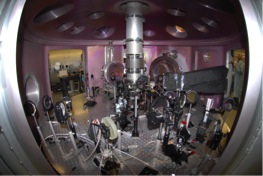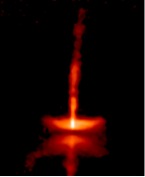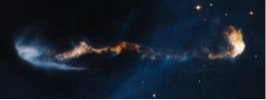

Astrophysical jets are naarrow beams of matter which can extend over considerable distances (hundreds of times the distance of the Earth from the Sun) They are an ubiquitous feature of the Universe, emerging from objects as diverse as embryonic stars, white dwarfs, neutron stars and black holes : their common feature is that they sweep up matter from their immediate environment, via a rotating disc of matter. Although they are spectacular objects, these jets were for a long time considered to be just the byproducts of the matter accretion process. However, physicists have gradually realized that in point of fact they play a crucial role in this phenomenon. For example, the jets jets which emerge from the poles of stars being born slow down the rotation of the gas which is collapsing onto the core, thereby enabling matter to continue to accumulate. Furthrmore, their effect on the interstellar medium can lead to the birth of new stars. Nevertheless, in spite of their importance, jets are still among the most poorly understood phenomena in modern astrophysics. In particular, current theories are unable to explain how matter can be chanelled along such large distances while remaining confined to such narrow jets.
Thanks to the first laboratory simulation of this phenomenon, and to three-dimensional numerical models, scientists have realized that the jets emitted by very young stars are collimated by a large scale magnetic field aligned along the axis of the jets, as has recently been confirmed by telescopic measurements. The mechanism suggested by the scientists is thus in very good agreement with current astrophysical observations. It explains in particular the mysterious X-ray emission along the jets which was observed by the Chandra satellite.

Lasers and coils to reproduce the interstellar environment
These results were made possible through a recently patented experimental device, which combines high power lasers with intense magnetic fields. By ripping electrons from a piece of plastic using a laser beam, the LULI physicists created a sample plasma2, representing on a small scale the atmosphere of a young star. However, the essential point was the creation, using coils made at the LNCMI, of a sufficiently intense magnetic field as to reproduce the interstellar environement, on a scale of a few cubic centimetres and for a few millionths of a second. Physicists at the LERMA and the LULI, helped by foreign collaborators, were then able, using supercomputers, to compute models of embryonic young stars and also of the laboratory experiment. The agreement between these two simulations has confirmed the key role played by the interstellar magnetic field.
In this work, the scientists were interested specifically in the plasma jets of embryonic stars, but in fact the same mechanism could apply to other kinds of astrophysical jets. Furthermore, this work opens the door to the practical study of the role of magnetic fields in astrophysics. In particular, the scientists hope to be able to investigate how young stars accumulate matter, cosmic rays and the plasma arcs ejected during solar eruptions. Finally, the device built at the LULI could be applied to research on controlled nuclear fusion, where magnetic fields have been proposed for a long time as a means to confine the ions within the fuel and raise their temperature, which is the key parameter for successful fusion.
1 This work has involved scientists from France, Italy, Gerrmany, the United Kingdom, Russia, the U.S.A. and Canada.
2 A n plasma is an ionized gas, made up of ions and free electrons.
3 Cosmic radiation is a flux of very energetic charged particles coming from space, whose precise origin we do not know.
Bibliography
Laboratory formation of a scaled protostellar jet by coaligned poloidal magnetic field, B. Albertazzi,A. Ciardi, M. Nakatsutsumi, T. Vinci, J. Béard, R. Bonito, J. Billette, M. Borghesi, Z. Burkley, S. N. Chen, T. E. Cowan, T. Herrmannsdörfer, D. P. Higginson, F. Kroll, S. A. Pikuz, K. Naughton, L. Romagnani, C.Riconda, G. Revet, R. Riquier, H.-P. Schlenvoigt, I. Yu. Skobelev, A.Ya. Faenov, A. Soloviev, M. Huarte-Espinosa, A. Frank, O. Portugall, H. Pépin, J. Fuchs. Science, 17 octobre 2014.
DOI : 10.1126/science.1259694. Lien : http://www.sciencemag.org/lookup/doi/10.1126/science.1259694
The experimental setup used for this work.
The central structure of this experimental chamber enables one to study the laser-matter coupling in the presence of strong magnetic fields and in a vacuum


![<multi>[fr]pdf[en]pdf</multi>](IMG/gif/pdf.gif)